Summary
There’s been a long-held belief that the closer a property is to the CBD, the better the growth over the long-term. But the data suggests the benefits might be insignificant. And there are plenty more problems investors need to be aware of too.
Past research
Prior research on this topic has had a couple of flaws. I won’t reference them in this blog. You’ll have to read the full report for those gory details. But in a nutshell:
- Time-frames too short
- Small sample sizes e.g., single city
- Arbitrary finish lines
After years of examining the long-term growth charts comparing two suburbs, I’ve seen that quite often the lead swaps over their history. And the longer the time-frame, the more times the lead swaps.
“The winner depends on when you choose to put the start and finish lines”
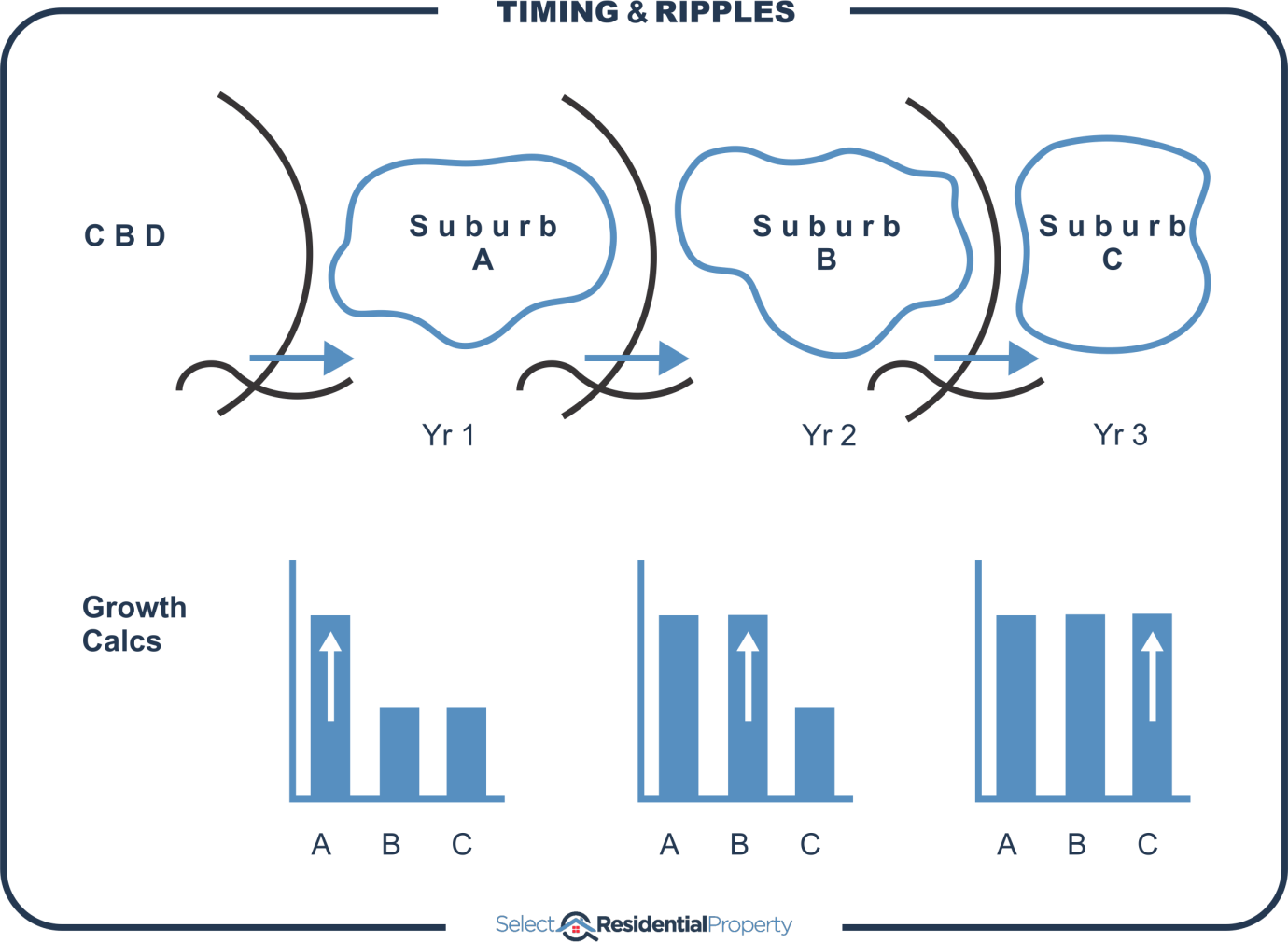
City growth spurts start in the centre and flow out towards the fringes. When inner suburbs have finished their most recent growth spurt, outer suburbs may only be starting theirs.
My methodology
Here’s my own analysis which overcomes some of the prior studies’ shortcomings. I’m going to consider all cities around the country with a population of 1,000,000+. This gives us clear enough CBDs and loads of suburbs in each city – the vast majority of Australia’s properties, in fact.
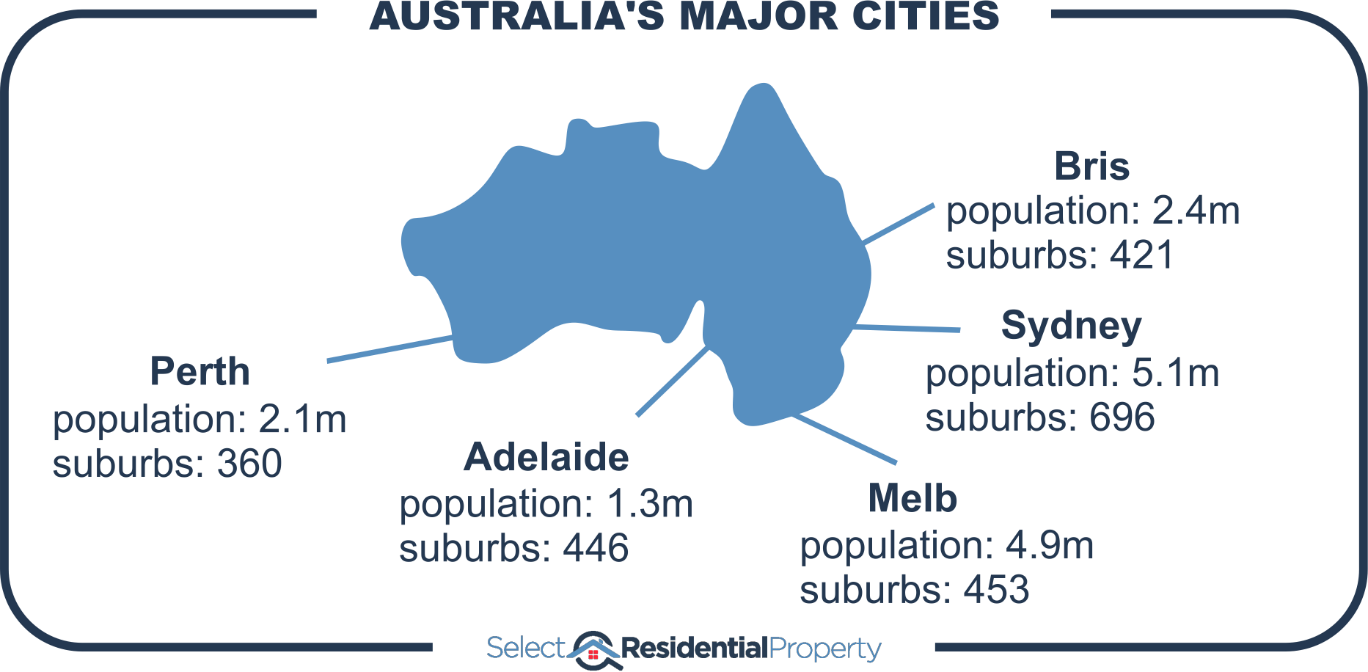
Source: ABS 2018 Estimated Resident Population
The analysis must also cover multiple time-frames, especially long-term and multiple distances from the CBD.
What constitutes a ring?
Instead of coming up with arbitrary distances in km from the CBD for each city, I’ve categorised a suburb as being within the inner ring if it is one of the closest 10% of suburbs to the CBD. Then I define a further 9 rings. This way, we can chart the growth rates of each ring to see more clearly if there is a trend.
And this approach easily handles cases where the shape of cities is not a perfect circle due to natural boundaries like mountains, rivers or the ocean.
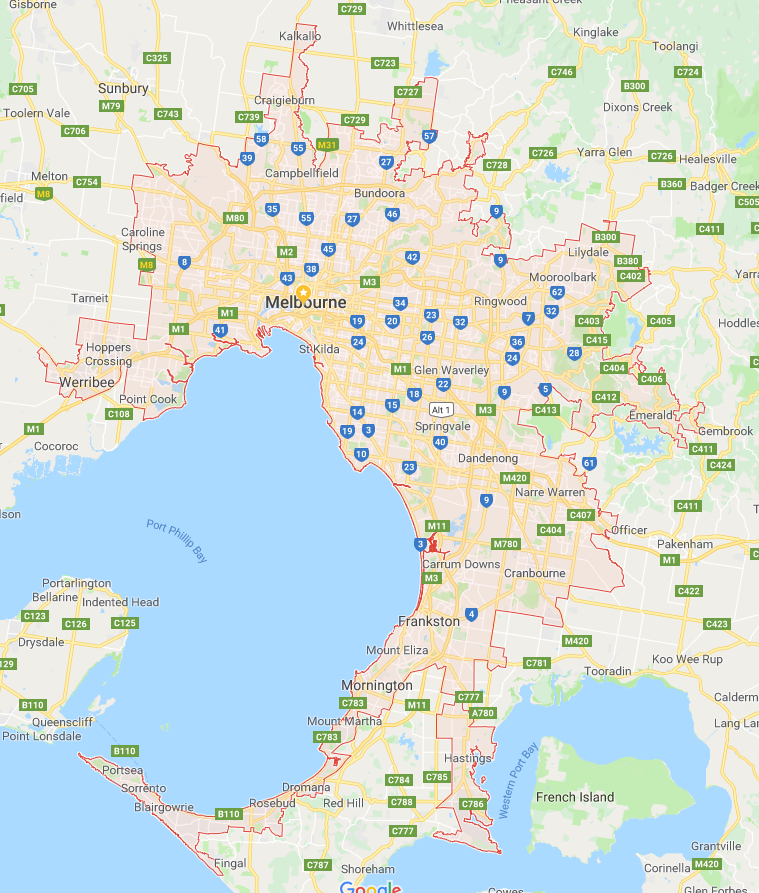
This approach of using the closest 10%, works consistently for each city regardless of its size or shape and how that has changed over time.
Another benefit of this approach is that each ring will have roughly the same number of suburbs for any given city. This way it’s harder to argue that one ring’s growth calculations are less reliable than another’s. Although there is a bias, which I’ll cover later.
Also, because cities expand, what was considered outer ring decades ago, could now be considered middle ring. Using a decile approach means we can look at the same city across different time-frames and get a consistent result. We don’t have to guess where the “middle ring” was 30 years ago and shift the boundary for each ring for each time-frame.
Rings as deciles
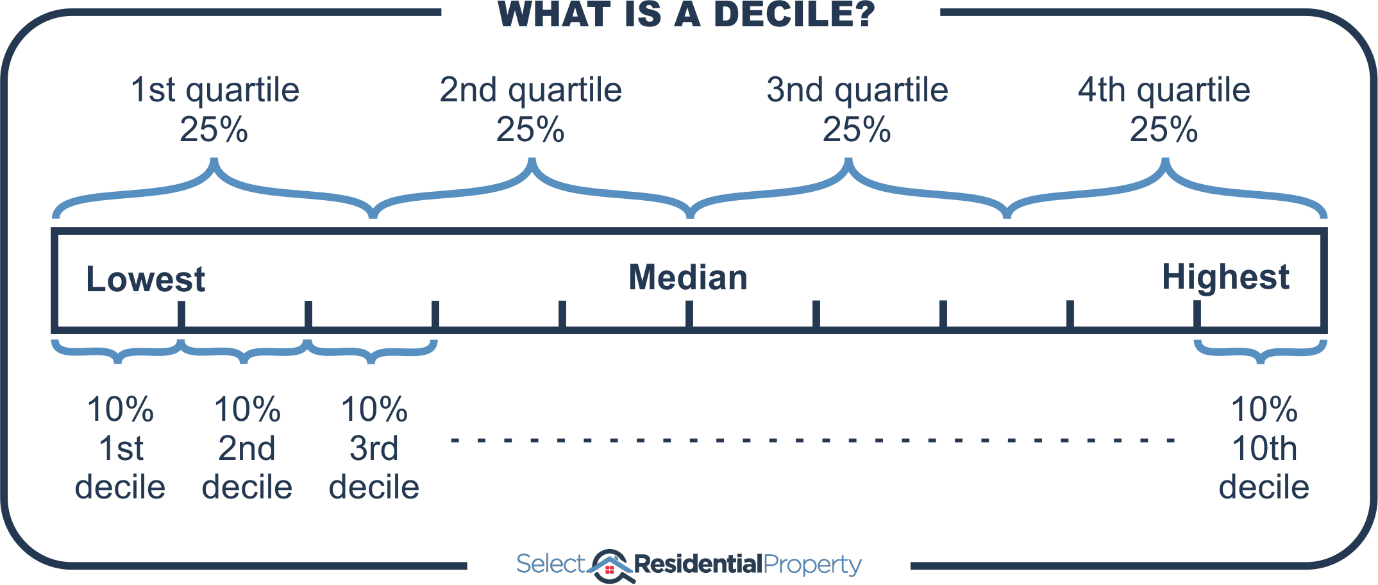
The closest 10% of the city’s suburbs to the CBD are in the first “decile”. Those suburbs that are in the furthest 10% are in the last decile, the 10th.
For example, since Sydney has around 700 suburbs, there are roughly 70 suburbs in each decile.
- 1st decile
- BARANGAROO 1 km from CBD
- NORTH SYDNEY
- ROSE BAY 5 km from CBD
- …and many more
- 2nd decile
- BRONTE 6 km from CBD
- SUMMER HILL
- BALGOWLAH 9 km from CBD
- …and many more
- …more deciles
- 5th decile
- DUNDAS 18 km from CBD
- THORNLEIGH
- CRONULLA 22 km from CBD
- …and many more
- 6th decile
- WESTMEAD 22 km from CBD
- MENAI
- FAIRFIELD WEST 26 km from CBD
- …and many more
- …more deciles
- 9th decile
- EAGLE VALE 41 km from CBD
- PITT TOWN
- PENRITH 49 km from CBD
- …and many more
- 10th decile
- GLENMORE PARK 50 km from CBD
- BLAXLAND
- KATOOMBA 85 km from CBD
- Yeah Katoomba is now considered part of Sydney!
- …and many more
We can apply this decile approach to any city now and avoid arguments about the size of rings and what constitutes inner or outer.
Research results
Here’s what I found by examining growth data for the last 40 years.
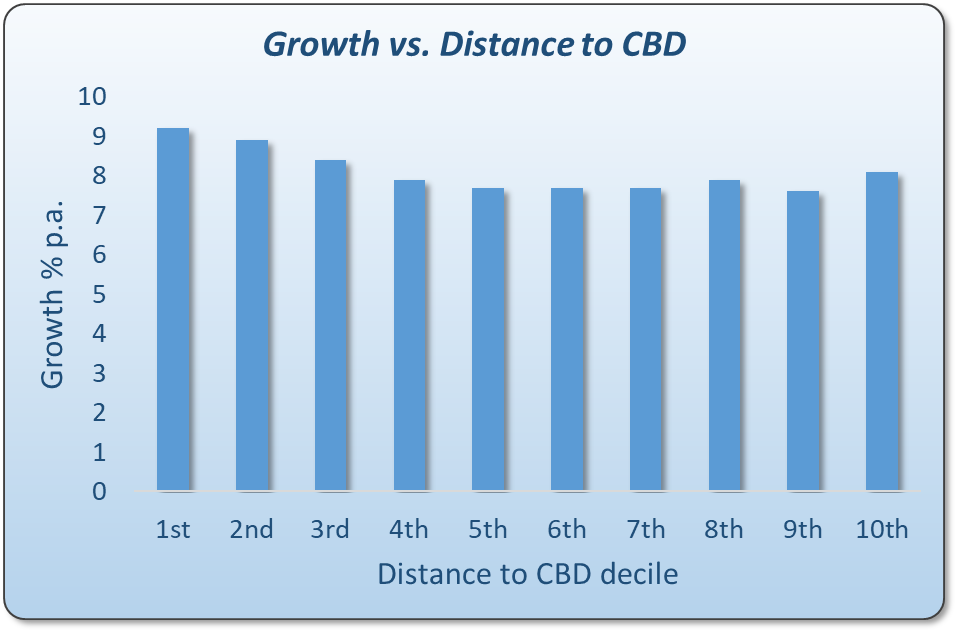
The 1st decile is the one closest to the CBD which appears on the left of the chart.
The cities examined included: Sydney, Melbourne, Brisbane, Perth & Adelaide.
The outermost decile clearly underperformed the inner most. So, at first glance it appears as though there may be something in this tactic of buying closer to the CBD.
However, there are a couple of issues. Firstly, notice the trend of diminishing growth the further you are from the CBD. It stops about half way through the deciles. It could be argued that this tactic might only work when choosing between the inner rings.
Also, notice that most of the deciles had growth between 8% and 9%. That seems very high by today’s standard, especially over 40 years. I’m using the Core Logic 12-month medians dating back to 1980. Could our data have included an outlier era of abnormally high growth that favoured certain rings?
And remember what I said about when you set the start and finish line. We should have a look at the last 20 and 30 years. 40 years is too long to wait for above average growth anyway, especially if you’re planning on retiring early.
Growth versus distance from the CBD for the last 20 years looks like this:
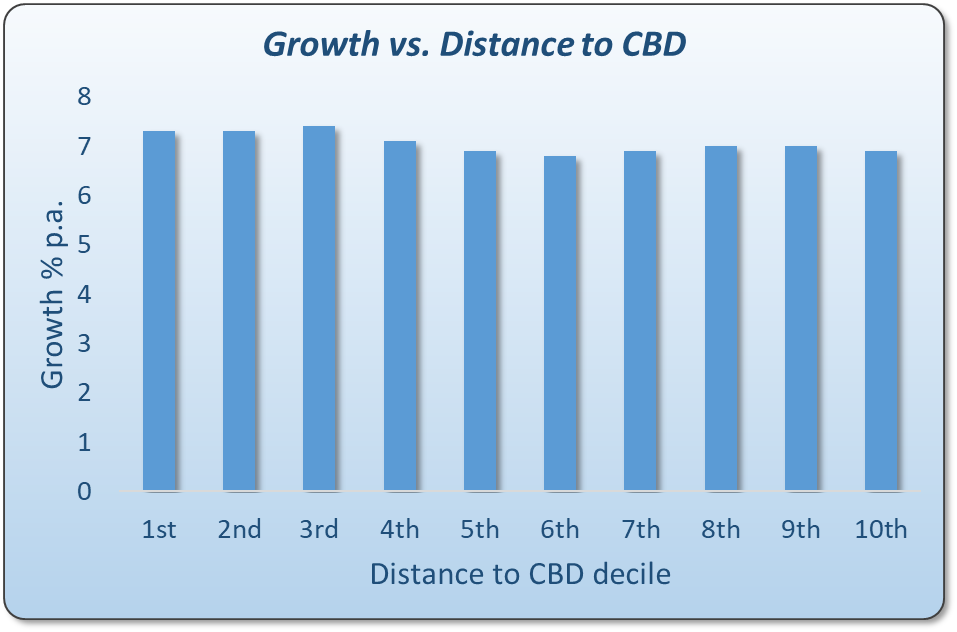
The 20-year comparison is a lot flatter. This is what we’d call a “statistically insignificant” correlation. The growth rates are all very similar. And more importantly, they’re all what we’d consider to be “normal” now days.
Growth versus distance from the CBD for the last 30 years looks like this:
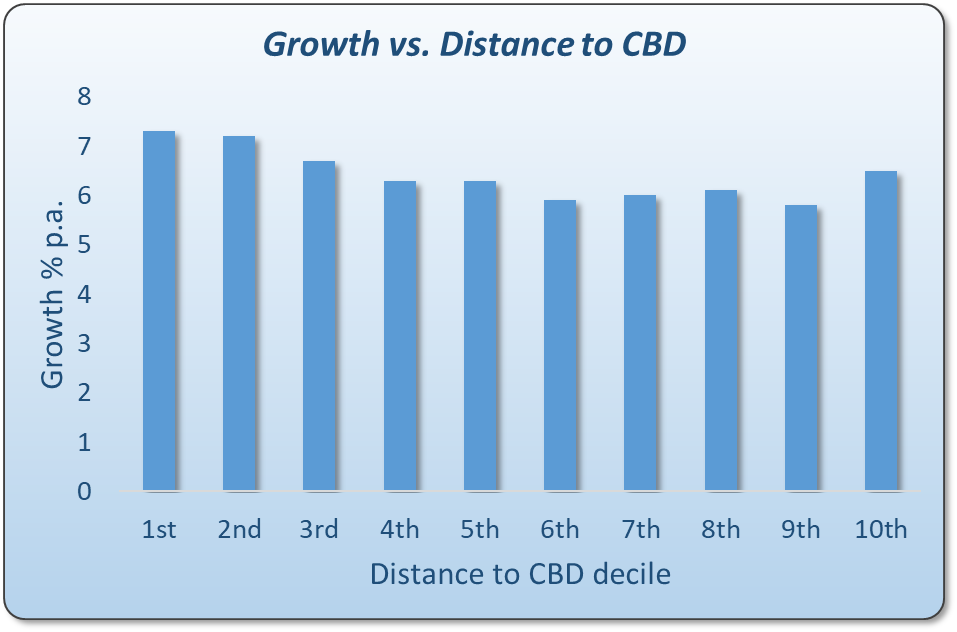
This chart shows there is actually a trend towards higher growth the closer to the CBD. But given how evenly we distributed suburbs; we can’t assume the 10th decile is an outlier. It’s beaten 6 of the other 9 deciles but is the furthest from the CBD. There could be more to the story than is told by these charts.
For completeness, here’s the same chart but covering the last 10 years.
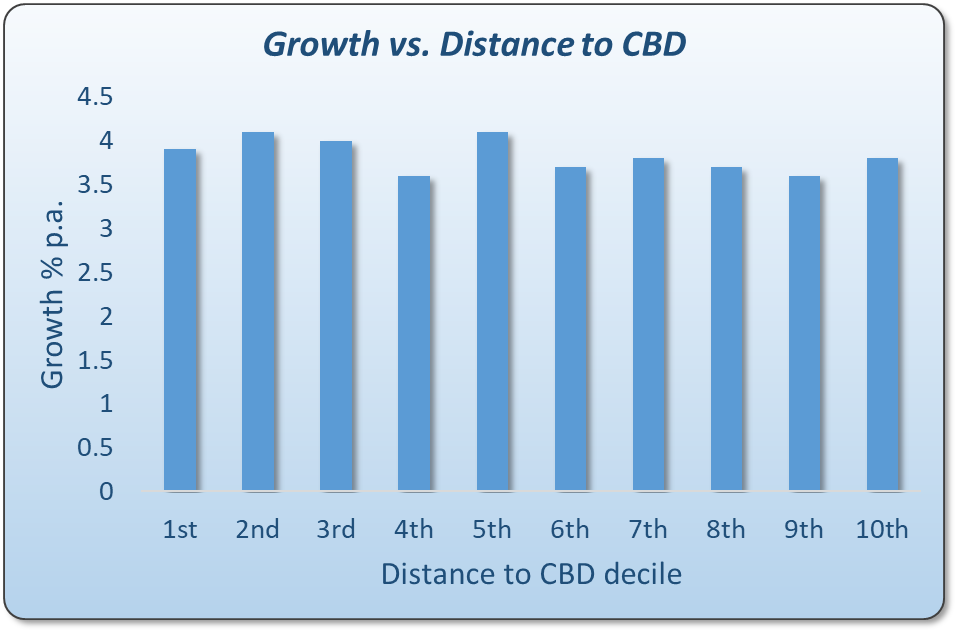
Again, the trend has reverted to being relatively flat and there are more inconsistencies like the middle ring being the best.
Changing the cities examined didn’t really alter the overall results. However, there may be some argument that specific cities have a closer relationship to CBD proximity and capital growth than others. It might come down to traffic congestion and the relative spread of amenities or jobs around the city. Some new infrastructure or jobs node might alter the course of growth.
At this stage, I have to admit there might be a case for buying closer to the CBD. But there are some more issues that need to be addressed which places more doubt on the tactic.
Bias
There’s a fundamental problem with the way in which capital growth was calculated for the prior section. And there are a couple of other issues to consider too:
Subdivisions
Outer ring suburbs are more likely to have blocks of land undergo subdivision. This will skew the growth calculations for outer rings unfairly lower than for rings in which subdivision is less common.
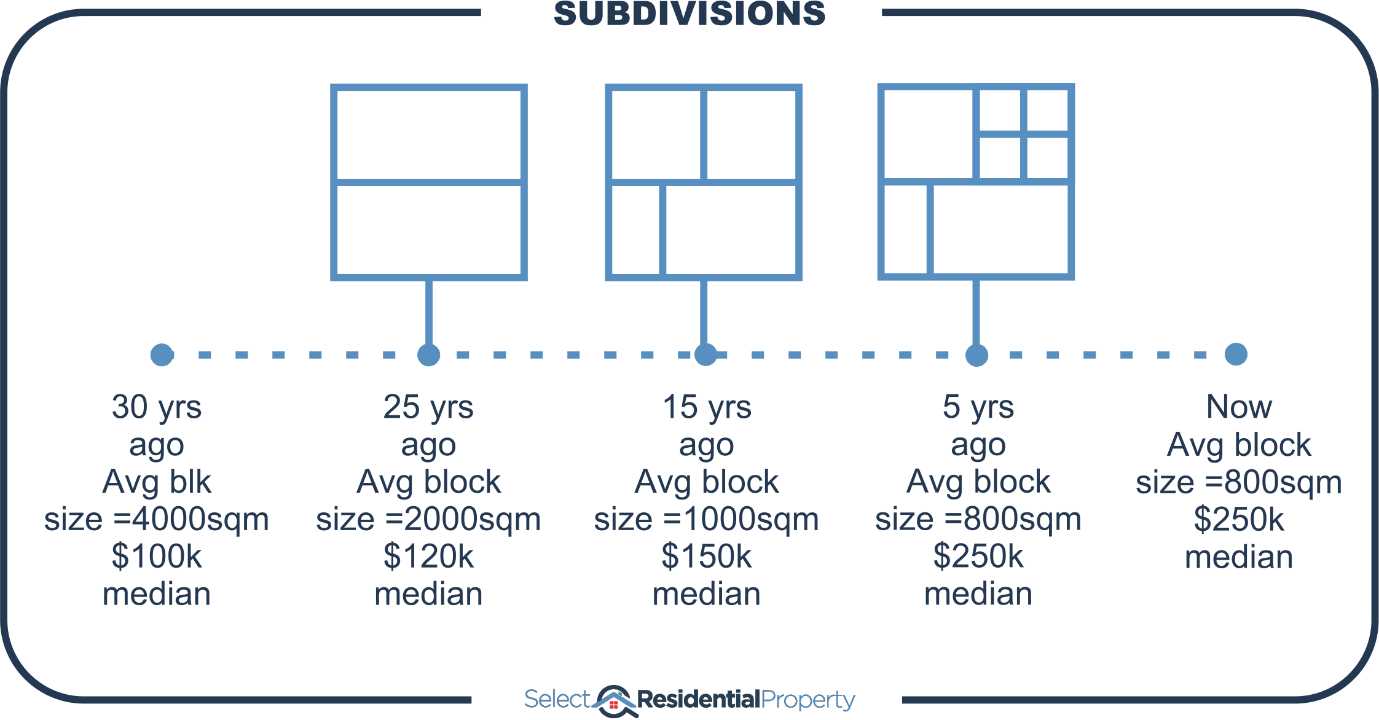
Imagine an outer ring suburb 30 years ago where the average size per block was 4,000 square metres. Now imagine if each block is split in half some time over the next 10 years – therefore losing roughly half its value. But imagine if the value of land in the suburb on a “per square metre” basis doubled over the same 10 years, then the median wouldn’t change. It would look like there was no growth simply due to subdivisions.
Assuming the outer-most ring was subdivided in this way, its true growth would be higher than what we calculated it to be.
But what if inner ring suburbs underwent the same kind of subdivision?
Analysis I conducted of changes in block sizes over the last few years shows that the inner most decile has a fairly static block size. Over the last 4 years the median block size has dropped by only about 1% per annum country wide in inner decile suburbs.
Contrast this with the outer most decile which has had a block size reduction rate 5 times faster. Block sizes in the outer most ring were possibly 4 times larger 30 years ago. But the inner-most ring block sizes were only about 30% larger than what they are today.
- Inner decile 1% pa block size drop
- Outer decile 5% pa block size drop
- Outer decile blocks possibly 4 times larger 30 years ago
These are rough estimates, but show the extreme impact subdivision can have on value.
Square metre land values
The best means therefore of comparing growth profiles of inner rings to outers is by examining the change in square metre land values. That way it doesn’t matter how big a block is or how many times it’s been subdivided over the years.
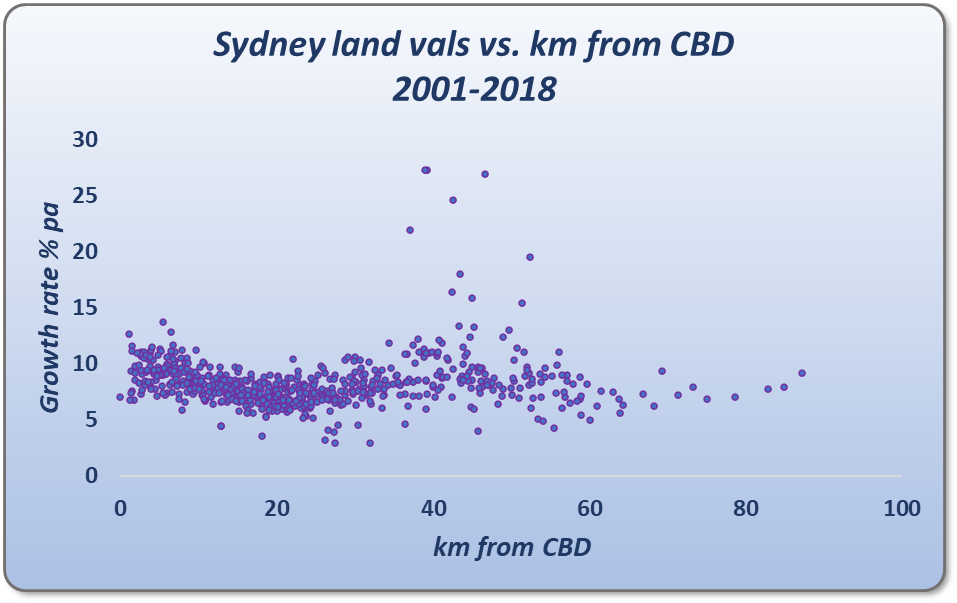
This chart is a scatter plot showing the growth in per square metre land values from 2001 to 2018. Each dot on the chart represents a suburb somewhere in Sydney.
The higher the dot, the more growth in the per square metre land value that a suburb had in that time-frame.
If the dot was over to the left of the chart, it was for a suburb close to the CBD. If the dot was over to the right of the chart, it was for a suburb far away from the CBD.
If proximity to the CBD meant faster growth in land values, then we’d expect the dots to be higher on the left of the chart, closer to the CBD. And we’d expect suburbs further from the CBD to have dots in the bottom right corner of the chart. But it doesn’t look like that’s the trend.
Speaking of trends, I’ve added one to the chart. It’s the dashed amber line. This is the line of best fit which runs through the centre of the dots.
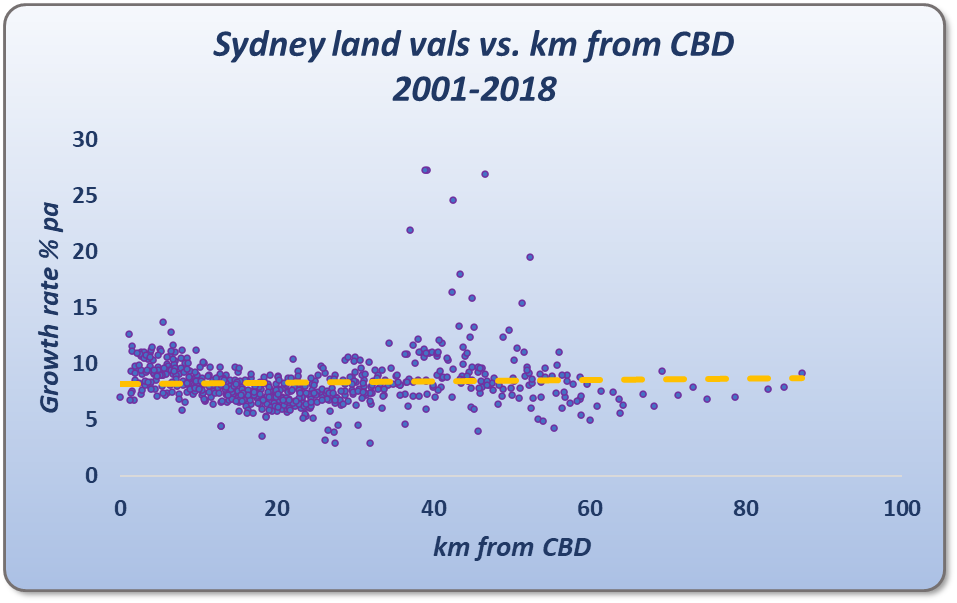
As you can see the trend line looks pretty flat. This adds more weight against the argument that proximity to the CBD is a growth driver. It didn’t really work out for Sydney over this time-frame according to change in per square metre values.
Also, this data was for only one city and a relatively short time-frame. Unfortunately, data isn’t available for a much longer time-frame or for other cities.
Yield
Another thing to consider is yield. There’s an inverse relationship between yields and distance from the CBD.
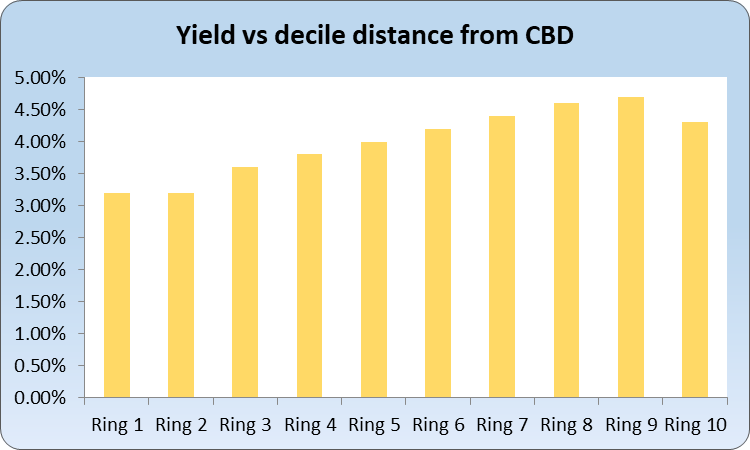
That is, the further away you are from the CBD, the higher the yields tend to be.
You can see in this chart that the suburbs closer to the CBD, to the left, have lower yields than the suburbs further away to the right. In fact, there’s 1.1% more rental income per annum in the outer most ring than there is in the inner most ring.
The relationship between yield and distance from the CBD is a lot clearer than the growth difference.
Other considerations
Overall, performance might have appeared slightly in favour of inner rings until subdivisions and yields were considered. To further complicate the comparison there are some non-performance related factors to consider, like:
Risk
Inner ring suburbs have more expensive properties than in the outer rings. More expensive properties have been shown to be more volatile than cheaper ones as this chart shows.
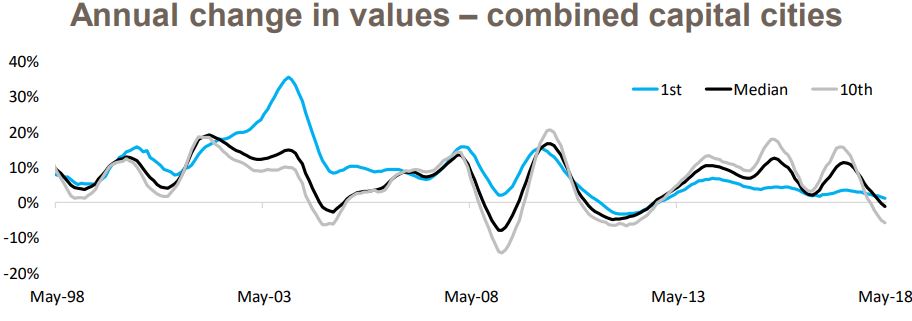
This chart comes from Core Logic’s decile report. They’ve plotted the growth of the top 10% most expensive property markets in each capital city. That’s the grey line. They’ve also plotted the growth profile of the cheapest 10% of property markets in all the state capitals, that’s the blue line. The black line is the combined capitals median growth rate. The data covers a 20-year period.
The more expensive property markets, closer to the CBD are more volatile. Volatility is a measure of risk. The more volatile a market is, the riskier it is considered to be.
Also, the chart shows that negative growth is more common in expensive markets than in cheaper ones.
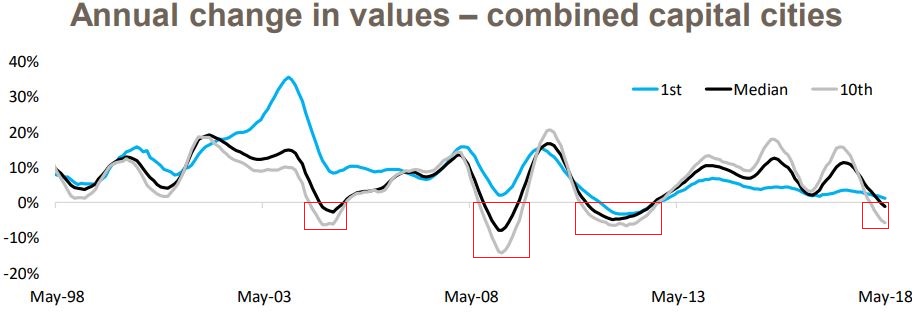
Out of the 4 cases when prices went backwards, expensive markets had the worst growth. Cheaper markets actually missed negative growth in 3 of those 4 cases.
Diversification is another weapon an investor can use against risk. Instead of spending $2m on an inner ring property with all your eggs in that one basket, you could spread the eggs around into 2 properties in different suburbs of a middle ring. They could even be in different cities.
Flexibility
There might be a case where you need to sell your property. You might not need all the sale proceeds, but you can’t sell half the property.
A single expensive property prevents you from being able to sell down a portion. A couple of cheaper properties, gives you the option to offload just one.
Capital Gains Tax (CGT)
If the occasion arose to sell your property, you would have to pay CGT. The CGT would be based on your marginal tax rate for the year in which you sold the property.
If you had instead bought 2 properties at half the price, you could sell one on June 30 of one financial year and the other a day later in the next financial year. This might significantly reduce the overall CGT paid for owners not in the top tax bracket.
Stamp duty
Stamp duty is based on property price. Most states have bracketed stamp duties - the more expensive properties have higher stamp duty rates than cheaper ones.
Buying closer to the CBD, you’d pay more in stamp duty than buying 2 cheaper properties further from the CBD. Long-term though, stamp duty is virtually inconsequential.
Timing entry
Ideally, you want to buy just before prices start their next growth phase. When a city-wide boom happens, it starts from the centre and ripples outwards. You have the recent 6 to 24 months of inner ring price growth history to view. You can use it to time entry into a middle ring suburb. But there’s no such cue for when inner rings start booming.
Suitability
An investor’s ideal market is:
- Low risk
- High growth
- High yield
Usually, an investor must pick what is most important for them at a certain stage in their life. For those nearing retirement, for example, low risk will be a high priority. Similarly, a high yield will be important to cash-flow their retirement lifestyle.
- Low risk
- High growth
- High yield
At the other end of the spectrum, younger investors that are building equity will consider growth to be more important.
- Low risk
- High growth
- High yield
Ironically, older investors are more capable of buying in the more expensive inner rings because they usually have so much more equity. But they’re the investors more likely to want cash-flow to fund their retirement. And inner rings have the lowest yields.
Younger investors on the other hand will not be able to afford inner ring suburbs, but they might be in a better position to cope well with cash-flow losses and with more time to recover from periods of worse negative growth.
For the majority of property investors, inner rings will be a less suitable choice for their current stage of life.
Opportunity
Inner ring markets lack the ability to change rapidly. Inner ring markets have everything they need already: transport nodes, shops, work centres, etc. They have already fully gentrified. They are unlikely to go through a significant change that spikes their growth rate.
Outer ring suburbs may have nothing to begin with. But the extension of a train line, for example, may dramatically improve growth prospects.
Conclusion
Past reports suggesting properties closer to the CBD outperform those further away have been flawed to some extent. The data suggests that long-term there’s not much in it. There are many better decisions investors can make to outperform the averages than worrying themselves with CBD proximity.
For more detail, check out the full report, “WHY THERE’S NO NEED TO BUY NEAR THE CBD”
....................................................................................
 Jeremy Sheppard is head of research at DSRdata.com.au.
Jeremy Sheppard is head of research at DSRdata.com.au.
DSR data can be found on the YIP Top suburbs page.
Click Here to read more Expert Advice articles by Jeremy Sheppard
Disclaimer: while due care is taken, the viewpoints expressed by contributors do not necessarily reflect the opinions of Your Investment Property.